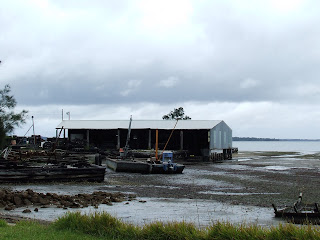 The birthplace of Western development in Port Stephens. Old Tahlee House has a pleasant outlook over gardens and water ways and was an official residence in the early days of the Australian Agricultural company. The very first house had a fire and was rebuilt. It had passed into private hands in 1856. Remnants of Kitchen and servant quarters as well as a cellar exist from those first days.
The birthplace of Western development in Port Stephens. Old Tahlee House has a pleasant outlook over gardens and water ways and was an official residence in the early days of the Australian Agricultural company. The very first house had a fire and was rebuilt. It had passed into private hands in 1856. Remnants of Kitchen and servant quarters as well as a cellar exist from those first days.The Tahlee Bible College now has the estate and is interested in the heritage and conducts guided tours. More information is on their web site here.
A former owner had been very interested in establishing a beautiful garden and in entertaining guests. They journeyed there by water in a steam yacht to moorings in a quaint little harbour then up the steps and terraced garden to join the party.


The AA Company was quite active in the settlement of the colony. The Australian Ag was formed in England by the big end of town in 1824 with the prospect of a grant of one million acres from which to reap exports from the new colony. Tahlee was the focus of one such vast property. The hills, the forrests, the cedars, lakes and wonderful river valleys were handed over by the Worimi people to the Agricultural company in 1828.
The 'expert' adventurer, Dawson was in charge of the development. By horseback his group travelled up the beaches from Newcastle to the bay and Dawson went to the northern side as the desired location for sheep raising and fine wool. Tahlee was the gateway somewhat in the path of the southerly weather. The Arctic explorer, Parry, was the next appointed commissioner and his previous xperience was transferable, we hope!
However, the land was unsuitable for sheep grazing and stock was eventually moved to more suitable areas inland. Stroud was one village among the local develoment. It wasn't easy to fine enough settlers and labour was scarce. Coal and minerals deposits were investigated. Road and rail links were envisaged but did not proceed. Overall, the venture enjoyed only limited success at this site. In 1849 the company ceased to use Tahlee house and it was sold to Manton in 1856 and the lands were eventually sold.

From the old homestead down to more of the Bible college and the hall painted green. A swimming pool is on the shores. A path from Tahlee house leads down to a tiny boat harbour lined by stone work carefully built in the early days.

The college would be reminiscent of any church mission in some far flung country in its collection of ad hoc buildings and idiosyncrasies typically found sitting in an idlyic location.
Times change and the Bible College is setting up an accredited language school for teaching English to overseas students in what is a competitve market. The country lifesyle and water sport has something to offer them.
Other church activites and camps are undertaken on the campus.

The Hall. This is of interest to those who knew Greta Migrant 'Camp' (for post-war immigrants). No mean feat, the hall was moved from the Migrant camp, several hours drive away, by groups of volunteers using their vehicles to get it there. In reassembling, the arrangment of the windows has been changed. Curiously, the admin office is on the stage!



The locality was called Carrington. Out beyond the Bible College, nearby, is a group of houses and an oyster farm. A happy Labrador was 'fishing' off these old timbers. A little church was built here very early on. It became a youth hostel.

Leaving Tahlee is a subdivision where most of the land has been zoned non-urban and regular sized buildings or occupation has been prohibited. It appears to continue to be bought and sold.

North Arm Cove in the same area is a more recent village resting by the shores like a ghost town on this particular day.
Close by is the site of a grand plan for Port Stephens city prepared by Walter Burley Griffin (American designer of Canberra).
Two thousand lots were subdivided on the ridges of a modern metropolis with glorious wide and curved streets and public spaces approved by Stroud Shire in 1918. A rail link was envisaged to go with this proposed major port and naval base in the name of commendable decentralisation. But before too long it was decided that a port so close to Newcastle was economically untenable.
Pindimar, to the east, on land from the AA company, also had big plans for a city by Walter Scott-Griffiths but they did not go ahead either. Biding their time?
The data is from works by Armstrong (1996) Fraser (2002) and Goold (1981).

No comments:
Post a Comment